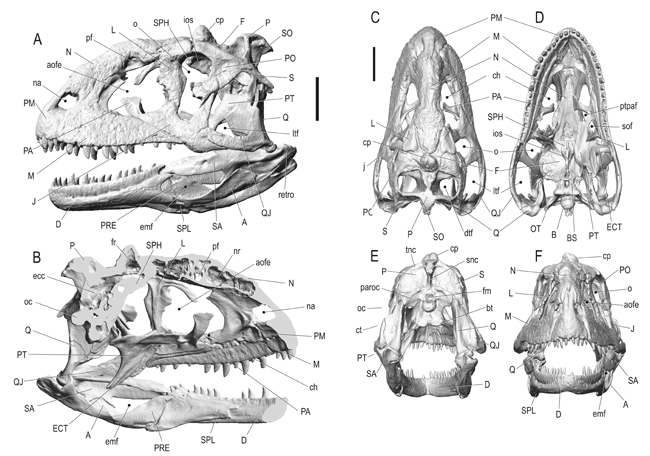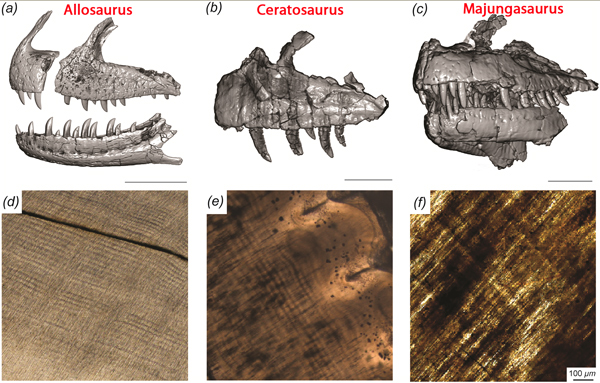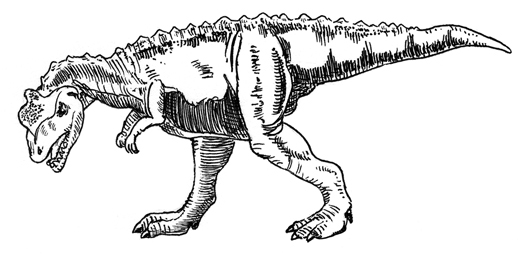New Study Demonstrates Majungasaurus Replaced Teeth as Fast as Herbivorous Dinosaurs
Majungasaurus – Elevated Tooth Replacement Rate
Scientists writing in the academic journal “PLOS One”, have really got their teeth into an aspect of dinosaur anatomy, that surprisingly has not attracted that much research to date. Dinosaurs replaced their teeth, as teeth were shed, perhaps when feeding or fighting, then replacements would erupt from the gumline permitting these reptiles to retain their toothy grins.
The speed of tooth replacement can provide palaeontologists with important information about feeding ecology. The fastest tooth replacement rates had been associated with herbivorous dinosaurs, the likes of the Ceratopsia and the hadrosaurids. After all, these plant-eaters fed on very coarse plant material so their teeth were subjected to plenty of wear and tear. In this new study, undertaken by researchers at Ohio University and Adelphi University (New York), tooth replacement rates for three carnivorous dinosaurs were calculated.
Surprisingly, Majungasaurus (M. crenatissimus), from the Late Cretaceous of Madagascar, had a much faster tooth replacement than the other theropods studied. Its tooth replacement rate puts it on a par with the rates associated with the horned dinosaurs and the duck-bills.
Computer Generated Images of the Skull of Majungasaurus

Picture credit: Memoirs of the Society of Vertebrate Paleontology/Ohio University/from Sampson, S. D. and L. M. Witmer (2007)
Rapid Replacement of Majungasaurus Teeth
CT scans and detailed cross-sectional analysis were carried out on individual teeth and jaw elements associated with three theropod dinosaurs. These dinosaurs were the blunt-snouted, deep-skulled Majungasaurus along with Allosaurus and Ceratosaurus. High tooth replacement rates were identified in three genera, but the researchers concluded that Majungasaurus replaced its teeth much faster than either Allosaurus or Ceratosaurus. Majungasaurus would form a new tooth in each socket every fifty-six days or so, whilst Allosaurus and Ceratosaurus took in excess of a hundred days.
Lead author of the research, Michael D. D’Emic, (Adelphi University), explained the significance of this finding by commenting:
“This meant they [Majungasaurus] were wearing down their teeth quickly, possibly because they were gnawing on bones. There is independent evidence for this in the form of scratches and gouges that match the spacing and size of their teeth on a variety of bones — bones from animals that would have been their prey.”
An Accelerated Replacement Strategy
Assistant professor D’Emic went onto add that extant animals too, gnaw on bones, this is a way for them to get certain nutrients, but to feed like this requires exceptionally tough and strong teeth, Majungasaurus did not have teeth like that, so they evolved an accelerated replacement strategy to compensate.
Examining Tooth Replacement in Theropod Dinosaurs

Picture credit: M. D. D’Emic et al/PLOS One with additional annotation by Everything Dinosaur
The picture (above), shows computer generated images of jaw elements of each dinosaur associated with the study (a) Allosaurus, (b) Ceratosaurus and (c) Majungasaurus. The images (d-f) show histological tooth sections which reveal incremental growth lines that can help to determine the individual age of teeth (d) Majungasaurus, (e) Ceratosaurus and (f) Allosaurus.
Using a statistical model to predict tooth age from tooth length measured in CT slices, replacement rates for these three genera are estimated at:
- Majungasaurus 56 days
- Allosaurus 104 days
- Ceratosaurus 107 days
The rapid replacement rate recorded in Majungasaurus puts it on a par with living sharks and herbivorous dinosaurs.
Building on Research from Twenty Years Ago
This research builds on an earlier paper published twenty years ago, the authors of this new study suggest that with so many new dinosaurs being named and described over the last two decades or so, there is a lot of scope to build on the data collected so far and to provide further insights into dinosaur feeding ecology.
Michael D’Emic stated:
“I’m hoping this latest project spurs more people to study other species. I bet that it will reveal further surprises and hopefully that will lead to a better understanding of how dinosaurs evolved to be successful for so long.”
Now that less destructive forms of study are available to scientists, the analysis of tooth wear and the internal structures of dinosaur teeth will help to provide a clearer picture regarding dinosaur feeding behaviour and dietary preferences – now that’s something to smile about.
An Illustration of the Late Cretaceous Abelisaurid Majungasaurus (M. crenatissimus)
Picture credit: Everything Dinosaur
The scientific paper: “Evolution of high tooth replacement rates in theropod dinosaurs” by Michael D. D’Emic , Patrick M. O’Connor, Thomas R. Pascucci, Joanna N. Gavras, Elizabeth Mardakhayav and Eric K. Lund published in PLOS One.
The Everything Dinosaur website: Everything Dinosaur.


